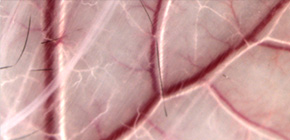
How homeothermic animals respond to changes in surrounding temperature clarified
Parallel arterial-venous alignment was the key to this finding
A group of researchers at Osaka University clarified a mechanism for controlling parallel arterial-venous alignment.
Research Institute for Microbial Diseases, Osaka University -- TAKAKURA Nobuyuki (Professor) and KIDOYA Hiroyasu (Assistant Professor)
Arterial vessels and venous vessels run side by side in the body; however, how parallel arterial-venous alignment is induced and the significance of parallel alignment had not yet been clarified. This group clarified that apelin, a bioactive peptide produced in arteries, acted on apelin receptors (APJ) expressed in veins, and veins are pulled to arteries, achieving parallel arterial-venous alignment. In mice with no parallel arterial-venous alignment, thermal exchange between arteries and veins was not performed and response to changes in surrounding temperature dropped. From this, this group verified that parallel arterial-venous alignment was involved in thermoregulation, clarifying a mechanism of blood vessels.
Angiogenic induction is a great challenge in achieving regenerative medicine using iPS cells. Controlling apelin will make the regeneration of the blood vessel network with functional circulating systems possible and contribute to the development of tissue regeneration studies.
Abstract
Molecular pathways regulating the development of arterial and venous endothelial cells (ECs) are now well established, but control of parallel arterial-venous alignment is unclear. Here we report that arterial-venous alignment in the skin is determined by apelin receptor (APJ) expression in venous ECs. One of the activators of APJ is apelin. We found that apelin is produced by arterial ECs during embryogenesis, induces chemotaxis of venous ECs, and promotes the production of secreted Frizzled-related protein 1 (sFRP1) by APJ + ECs. sFRP1 stimulates matrix metalloproteinase production by Ly6B.2 + neutrophil-like cells located between the arteries and veins, resulting in remodeling of extracellular matrices to support venous displacement. Moreover, using apelin- or APJ-deficient mice, which exhibit arterial-venous disorganization, we found that arterial-venous alignment is involved in thermoregulation, possibly by regulating countercurrent heat exchange. We hypothesize that the evolution of parallel juxtapositional arterial-venous alignment was an adaptation to reduce body heat loss.

To learn more about this research, please view the full research report entitled "APJ Regulates Parallel Alignment of Arteries and Veins in the Skin" at this page of the Developmental Cell website.
Related Link
